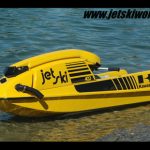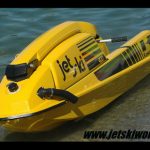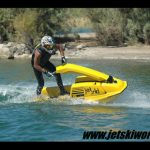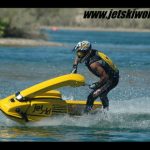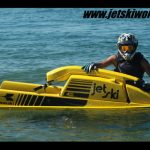Kawasaki JS400, 1976: Making history
We ride exclusively the first mass production Kawasaki stand-up, the legendary JS400, the watercraft that actually introduced this sport to the world.
Words:Vasilis Moraitis
Test rider:Vasilis Moraitis
Photos:www.jetskiworld.gr, Gary Hart
Kawasaki launched its first mass production Jet Ski, the legendary JS400 back in 1976. That particular year Kawasaki made history by putting the basis and creating a whole new sport, the sport of jet skiing. The logo itself –Jet Ski- was became a trade mark not only for the Japanese manufacturer but the whole sport. Even after 37 years of the production of the Kawasaki stand-up everyone it calling a personal watercraft as Jet Ski even if it is produced by another brand.
Gary Hart owner of Jettrim (the famous bitchin’ stitchin mats and seat covers) is not only a jet ski enthusiast but a passionate collector of Jet Skis. He was the guy who visualized the Vintage Jet Ski Museum and he started working on the idea back in 2010 where he initially presented it at the Performance Alley at the IJSBA World Finals. Having knowing Gary for years we set the particular test ride in Body Beach in order to find you how unique was Kawasaki’s project 37 years ago when the company decided to introduce a new way of having fan on the water. The yellow Kawasaki with black decals was restored exactly to its OEM condition so we could call this test ride as a back-to-the-past product test.
Back to the roots
The first things you notice is the position of the start/stop button which is situated in the front dash board just bellow your feet. This means that things get awkward when you approach the beach and you plan to switch off. The power band of the 400cc two-stroke engine is for user friendly that you would have expected especially considering the modern aspects of two-stroke engineering. Initially, I though that the engine was underpowered though it was a misunderstanding since I had picked up the craft after testing a mildly tuned three-cylinder SX-R…It was fan for sure, however I had to keep the momentum going and the engine revving up to the right rpm in order to go with the flow and keep the nose of the hull downwards. In general I had to be progressive on my moves and smooth on the riding style in order to keep the craft in plane and to avoid purpoise. However when I made a few laps on the small race course in Body Beach I had to pin the throttle in order to keep my pace. Most people would assume that the 27hp are not enough though back in the mid seventies the JS400 was impressively fast with a top speed of 31mph. If anyone still thinks that this speed sounds too low according to today’s standards well, bear in mind that in the 37 year of Kawasaki stand-up Jet Skis the engine output had increased from 27hp to 80hp and the top speed from 31mph to 49mph.
The compact two-stroke engine operates smoothly with a very characteristic sound which escapes through the left hand side through front deck exhaust outlet. The tiny waterbox is situated right in the front and it is responsible for this beautiful sound rather not noise which I have not heard for nearly 20 years.
The handlebars are very narrow and the bars are set in such an angle that actually forces you to keep the elbows stacked on your body. I had to keep thinking to keep my elbows apart in order to steer the craft properly and to maintain the proper stability.
The side rails of the deck were not covered with mats those days, a fact that lead to improper grip of the rider’s legs to the craft. Therefore, I would assume that this was one of the initial reasons that provided the idea to Gary Hart, owner of Jettrim to produce the one of a kind mat in order to enhance grip on these crafts. The width of this deck is so narrow which is very impressive of how those early stage riders managed to balance the craft so well. Actually, there was a saying back in those days which stated “if you new how to ride a JS400 well you could ride any type of stand-up in the future”.
The particular test was done in Body Beach under calm water conditions and no wind. It was a unique experience, en exotic trip to the past that made us respect a lot more the innovator of Jet Ski, Clayton Jacobson and Kawasaki which made the final decision to introduce this brand new powered vessel to the people. We thank Gary ones again for giving us this unique opportunity to travel back in the past and test the first mass production Kawasaki Jet Ski.
Specifications
Kawasaki Jet Ski JS400 1976
Engine
Type: 2T, vertical twin, water-cooled
Displacement (cc): 400cc
Bore x stroke (mm): 65 x 60
Power (hp/rpm): 27/6.000
Torque (ft lbs/rpm): 27/4,500
Compression ratio:7.0 :1
Fuel induction system: 1 x Mikuni BN38 diaphragm type
Exhaust system: Cast exhaust wet pipe with a 2-1 header
Cooling system: Engine-Exhaust-Open loop system
Fuel consumption (L/h): 5.7 l/hr @ 32kph (1.5gal/hr U.S.)
Hull
Hull material: Fiberglass reinforced SMC
Deck Material: Fiberglass reinforced SMC
Overall length (mm): 2133 (84in)
Overall width (mm): 610 (24 in)
Overall height (mm):635 (25 in)
Weight (kg): 111 (244 lbs)
Pump and drive line
Pump: Axial flow, single stage, 6-vane stator.
Pump diameter (mm): 121
Reduction nozzle diameter (mm): N.A.
Steering nozzle diameter (mm): N.A.
Impeller: Aluminum, three blade
Thrust (kg):100 (220 lb)
Fuel/lubrication
Recommend fuel: Regular Unleaded gas, 87+octane rating
Fuel capacity (l): 13 (3.5 gal U.S.)
Lubrication: Gas/Oil Pre-Mix 32:1 ratio





